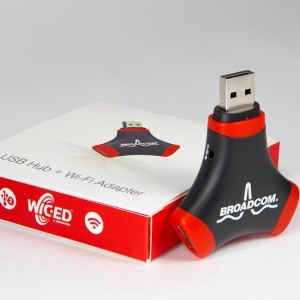Hands-On: Getting my Raspberry Pi Zero kitted out

While I was writing the recent series about the Raspberry Pi Zero, Raspbian and NOOBS I came across a new (at least to me) hardware accessory, the Broadcom Wi-fi Adapter and USB Hub.
I promised then to write about its compatibility and performance, so it is now time to make good on that promise. In the meantime I have picked up a couple of other useful bits of kit for the Zero, so I will combine them all in this post.

Broadcom WiFi USB Adapter
First up, the star of the show - the Broadcom USB Wi-fi Adapter and 2-Port Hub. This is probably the best add-on you can get for the Raspberry Pi Zero. It contains a wi-fi adapter, which is compatible not only with Raspbian but also with the NOOBS distribution stand-alone wireless networking configuration, so you can use it to load the other (non-Raspbian) operating systems from the latest NOOBS distribution.
When you plug this into the (one-and-only) USB port on the Raspberry Pi Zero, not only do you get wi-fi connectivity without using up that precious port, but it actually doubles the available USB ports to two: how good is that!
The BCM43143 wi-fi adapter integrated in this unit is a low-power and low-CPU load device, so it really is an excellent companion for the Raspberry Pi Zero. If you then plug a combined wireless keyboard and mouse USB receiver into one of the ports of the Broadcom hub, you have solved your three basic needs - keyboard, mouse and network connection - and you still have a free USB port. This is great stuff.
mini-HDMI to HDMI cable
The next thing I got for the Zero was a mini-HDMI video cable, so that I could get rid of the slightly clunky mini-to-full HDMI adapter. This is nowhere near as big of a deal as the wi-fi adapter was, and if you already have an HDMI cable that you could use with the adapter that is included with the Zero from most sources, then you probably want to spare yourself the expense of this cable. But if you are going to have to buy a cable anyway, getting one like this just helps to make things a bit less cluttered.
Speaking of cluttered, and thinking about the number of cables that have to be plugged into that tiny Raspberry Pi Zero, leads me to the next really important add-on. A case to help with some of the mechanical stress of the cable connections, and to protect the Zero from whatever might drop onto it on my desk (loose wires, coffee, whatever).
Pibow Zero Case
My friends at the Swiss Pi-Shop now have the Pibow Zero Case in stock. It is typical of the sandwich-layered cases that have been popular for the Raspberry Pi since the beginning. It provides physical and electrical protection, while leaving the power, USB, HDMI and GPIO connections accessible. It is transparent, so you can still wow your friends and family with the elegant simplicity of the Raspberry Pi Zero.
My only minor complaint about this case is that it encloses the micro-USB card slot, so if you want to swap the card you will have to at least partially disassemble the case. I doubt that this is a problem for the vast majority of Pi Zero owners, who will set up a card and be done with it, but because I sometimes swap cards while testing different operating systems, it is a bit of a bother for me. Not a big deal, though, and its way better than no case at all.
So, when I put all of these things together on my Raspberry Pi Zero, with a typical micro-USB power supply, it looks like this. I doubt that I will leave the wi-fi/USB adapter dangling out to the side like that, I will probably double-stick tape it to the bottom of the Pibow case.
Raspberry Pi Zero Kitted Out
This is a vast improvement over having the exposed Raspberry Pi Zero just laying on my desk, but it is still not the ideal configuration I have in mind.
Raspberry Pi B /2 Case
One more thing before I go. I also just picked up my first "genuine" Raspberry Pi Case for my Pi 2, and it really is very nice. Clean, secure and simple to assemble/install. The top pops off to make space for a HAT if necessary. Very nice.
Just think if they make a case like this for the Zero, along with a 2-port (or more!) USB Hub and integrated wi-fi adapter, all enclosed in the same case. Goodness that would be nice!
Read more on the Raspberry Pi